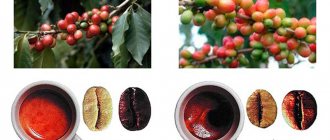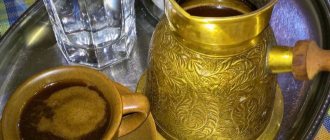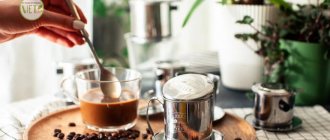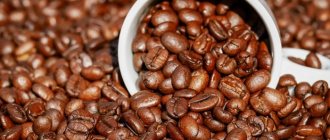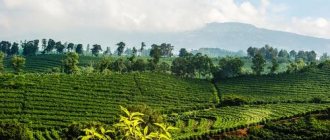This method of preparation is definitely not for coffee snobs or purists, but it will become a sweet spot on the coffee map of the world for lovers of an invigorating drink. Our article about Vietnamese coffee. Vietnam is not a rich country, so Robusta is more often consumed here than Arabica, and to diversify its taste, coconut or palm oil is added when roasting the grain. The grains turn out to be large, oily with a confectionery aroma that bears little resemblance to those we are used to. They don’t produce milk in Vietnam, so residents began adding our Soviet condensed milk to the drink, which they were accustomed to because of the humanitarian aid of the Soviet Union, back in the 50s.
So, Vietnamese coffee is sweet, invigorating (because Robusta has more caffeine), and perfectly cooling in the heat if you add a few ice cubes to the glass of the drink. Try it yourself!
Traditional brewing method via fin
by Mrviet
Vietnamese coffee
17.01.2018
Vietnamese coffee cup.
Vietnam ranks honorably second in terms of coffee production in the world. The taste of Vietnamese coffee is different from the Brazilian coffee we are used to. It is brighter, stronger and more aromatic. Having tried coffee in Vietnam, travelers simply cannot remain indifferent to it, and the point here is not only in the coffee beans themselves, but also in the special method of preparing the drink through a coffee fin (a cup or glass for brewing coffee).
The Vietnamese do not use a cezve or a coffee maker; they have their own special recipe. The reason for this recipe is that in Vietnam it is customary to roast the coffee beans until they are dark in color. Cooking such grains in a Turk will add bitterness to the drink. One common belief is that all Vietnamese coffee recipes are aimed at eliminating the bitterness of coffee beans. Another says that it is to eliminate bitterness that the Vietnamese use a metal press filter called “fin”. The design includes a metal housing with a filter, a press and a lid. This modification of the French press was adopted back in the 19th century from French missionaries.
There are several subtleties that you need to know before using the “fin”:
- Optimal for use in a press filter is medium or coarse grind coffee, this eliminates the possibility of small particles of ground coffee getting into the cup. If you want to make Vietnamese coffee in Turkish, then it is better to use finely ground coffee to obtain a rich taste of the drink.
- It is better not to pour boiling water over your coffee, but to use hot water only 1-2 minutes after it has boiled. The drink is served immediately after preparation.
- To preserve the taste and aroma of Vietnamese coffee longer, it is recommended to take ground coffee in small packages of 250 grams, coffee beans in packages of 500 grams, store them in closed, sealed packaging, away from light and temperature changes, so it will retain its taste and fragrance for up to 12 months.
HOW TO MAKE VIETNAMESE COFFEE IN A TEAMER (FINE):
- Take a glass, cup or mug of your favorite size.
- We put the fin on top.
- Add 2-3 teaspoons (with a heap) of aromatic coffee, distribute over the bottom and close with a press.
- Add a little boiling water, and after a minute fill the entire bowl with hot water, cover with a lid.
- We wait a couple of minutes until the coffee drips.
- Let's take off the fin and enjoy delicious coffee!
This cooking method is one of the simplest, cheapest and most delicious. In our online store, you can purchase a Coffee+Fin set and brew real Vietnamese coffee at home.
If you pour the finished drink into a glass with ice and add cream on top, you will get marbled Vietnamese coffee.
HOW TO BREW VIETNAMESE “WHITE COFFEE” WITH CONDENSED MILK.
- Pour condensed milk into a glass to taste, usually about 1 cm.
- Place a press filter on top of the glass.
- Pour 2-3 spoons of coffee into the filter (cup).
- Press with a press and pour boiling water.
- When there is no water left in the fin and all the coffee has dried out, remove the fin.
- Add ice and stir gently.
- Thick, strong and sweet, the drink is ready to drink, and you know the traditional secrets of making Vietnamese coffee!
In the hot weather, black and white coffee in Vietnam is drunk with ice; this drink has a refreshing effect. In cool weather, we suggest you replace condensed milk with hot milk or enjoy aromatic espresso.
It’s very easy to immerse yourself in the culture of the country and feel like a real Vietnamese coffee connoisseur; for this we have a “Mr. Viet" with Fin.
Go to shopping
Good to know, Coffee recipes
Vietnamese coffee varieties
The most popular types of coffee beans in Vietnam are Arabica and Robusta. Their varieties are sold both in pure form and mixed with each other in various proportions. But Luwak, extracted from animal excrement, is an attraction for tourists. The drink made from beans of this variety, offered at tastings, does not differ in taste from ordinary Robusta, and its “special” taste properties are caused by self-hypnosis. If you want to try real elite coffee, pay attention to excelsa - the rarest type that is part of exquisite varieties. When tasting coffee in Vietnam, trust not advertising, but your own taste sensations. Buy the varieties that you really like. And let your morning begin with the most delicious coffee in the world!
Previous
CuisineSeafood restaurants in Nha Trang: where to eat fish and seafood
How is coffee made in Vietnam?
The secret of the high productivity of coffee products in the Asian country lies in the large area of coffee crop cultivation (about 500,000 hectares) and almost year-round harvesting - it begins in October and ends in September of the following year. Most of the plantations are devoted to the cultivation of robusta (85% of all types of coffee in Vietnam). Arabica coffee (24%) and other varieties of coffee account for slightly less production. If the fastidious Arabica is grown in the north and south of the country at an altitude of 500-2500 feet above the sea (at an air temperature of at least 20 ° C), then the less fastidious Robusta thrives in a humid climate at an altitude of 600 meters above sea level.
At the end of the 19th century, the main production of coffee was concentrated in Nghe An province. Afterwards, residents of the Thai Nguyen district began to engage in this profitable business, now producing such a famous variety as Trung Nguyen. Today, the heart of Vietnam's coffee industry is Dak Lak Province. In its administrative center, Buon Ma Thuot, there is a coffee exchange.
Do you want to know who makes coffee in Vietnam and how? The leading role here is given to private farms. The production component is not much different from the technologies of other countries, unless you take into account the production of the elite Luwak coffee variety. Unlike the traditional method of coffee production, where it plays a role how savvy the Vietnamese is in his business, here everything depends on the mood and appetites of the animal - the palm civet.
Previously, this cute creature lived in the Vietnamese forests and, carefreely walking around in freedom, feasted on ripe coffee berries. Enterprising farmers collected their excrement, cleaned, washed and obtained coffee beans with a unique chemical composition. The opportunity to brew them and get an original coffee drink was initially given to the poor.
Today, enterprising businessmen keep these animals in special cages. As soon as their gastrointestinal tract begins to produce a special enzyme (this only happens for 6 months), the animals are fed exclusively with coffee berries. Afterwards, the civet eats regular food - vegetables or fruits. Keeping these animals is not cheap, so entrepreneurs often release civets into the wild for a while. In addition, they do not reproduce in artificially created living conditions.
While Guatemalan coffee has a specific shade of smoky notes, Vietnamese coffee is characterized by a high caffeine content. The fact is that when frying it, a technology different from the standard one is used. Coffee is roasted at lower temperatures in purified vegetable oil with the addition of spices and sweet syrups. What makes Kopi Luwak unique is that it has the typical bitterness of coffee. In search of an answer to the question of how to prepare Vietnamese coffee of this type, coffee lovers often study a lot of specialized literature. However, there are no secrets here - just choose the “Oriental” cooking method.
Coffee with milk
When accepting an order, a waiter in a cafe or a street food vendor will definitely ask if you need more milk. In Vietnam they only drink coffee with condensed milk. It gives the drink a delicate creamy taste. In this case, no sugar is added - otherwise the drink will be too sugary. The Vietnamese do not add milk to coffee, but a ready-made drink with milk. How to prepare cà phê sữa – milk coffee:
- Place 1-2 tablespoons of condensed milk into an empty cup.
- Brew coffee using a method you already know.
- Stir.
If you are used to drinking milk coffee, but condensed milk seems too high in calories and heavy, there is a recipe for making a flavorful drink with regular milk.
- Pour milk into a mug.
- Add sugar if you drink your coffee sweet.
- Place the milk and sugar in the microwave for 30-80 seconds (depending on the power of the oven and the amount of milk). Make sure it doesn't boil. You can also heat the milk on the stove.
- Try to immediately place the coffee filter on the cup, otherwise milk foam may form.
What kind of coffee is suitable for cooking in Finland?
To prepare coffee in Finland, you should give preference to medium-ground coffee. Finely ground coffee is more suitable for cooking in a Turk, and it can simply clog the perforated filter. If you use coarsely ground coffee to make coffee in Finland, the taste will be less intense and the drink will be less aromatic. But this option is liked by those who prefer more European tastes of coffee and a lower density of the drink.
